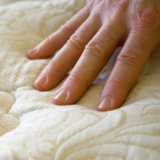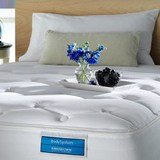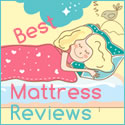Why Use an Organic
Portable Crib Mattress?
Every parent wants their children to grow up healthy, but did you know that a standard portable crib mattress tends to have a variety of harmful chemicals? Those chemicals include polyvinyl chloride (PVC) and phthalates, which make up the outside surface of the baby crib mattresses. The mattresses are usually filled with polyurethane foam, which is basically made out of petroleum oil.
Fire Retardants in Children's Mattresses
Both the inside and surface of those mattresses can be incredibly flammable and so are treated with toxic fire-retardants like antimony, arsenic, phosphorous, and pentaBDE. These chemicals are inexpensive and easy to manufacture, resulting in less expensive mattresses, but they pose a potential for harm to the babies who sleep on those mattresses.
From our research, we believe that these chemicals are dangerous to babies and people in general. PVC is said to be one of the most dangerous and environmentally destructive plastics. The FDA has issued warnings about phthalates, which are associated with increased risks of cancer, asthma, and reproductive harm.
Polyurethane includes toxic chemicals like formaldehyde, benzene, organotin compounds, and toluene. PentaBDE leeches out into the air and is believed to cause hyperactivity and neurological harm. As a result, pentaBDE is illegal in Europe and California, but cribs are still being manufactured with pentaBDE.
Older cribs frequently have other chemicals such as "Deca", a previously very common flame retardant, or Tris, a compound found to cause genetic mutation. Millions of older conventional crib mattresses include those chemicals and other similar ones. These substances can be avoided by using organic and hypoallergenic mattresses.
Safer Options for Baby Mattresses
Crib mattresses need not contain harmful chemicals; organic and hypoallergenic mattresses can be very helpful. Organic mattresses reduce the use of chemicals that children are exposed to and can potentially absorb. New organic mattresses also generally do not carry bacteria on the surface or fungus or mold growing inside the mattress, which older mattresses, especially conventional mattresses, risk. Fungi and bacteria are not things you want under your sleeping infant.
Conventional mattresses, in order to be fire resistant, also include all sorts of other chemicals that we think should be kept far away from babies. Organic and hypoallergenic crib mattresses use organic wool, which meets national guidelines for being fire resistant. It also resists mold, mildew, and dust mites and keeps children warmer. Organic wool is an excellent choice for a crib mattress, especially portable crib mattresses.
Organic and Hypoallergenic Crib Mattresses
While organic and hypoallergenic crib mattresses used to be less common, today there are a variety of options to keep your child healthy.
- The Colgate Portable Crib mattress is one excellent choice for babies. It uses plant oil rather than petroleum and comes with a cloth cover so that infants are not exposed to the chemicals found in vinyl and other conventional mattresses.
Many parents love this mattress, which is affordably priced and helps both parents and children get sleep. The mattress fits snugly with most mini cribs and is thick enough to be a solid option. The MDB Crescent Mini Crib Mattress is a great hypoallergenic portable crib mattress. It has just the right amount of firmness and definitely beats thinner pads. However, some have trouble finding sheets that fit well.
- Other options include the Naturepedic Organic Cotton Portacrib Mattress, which uses organic cotton. While relatively thin at just 2 inches, it nevertheless weighs 15 pounds to be a solid, firm sleeping surface. It has rave reviews from parents and fits well into cribs.
- The LA Baby Organic Compact Porta Crib Pad is another thinner mattress choice that many parents like and it fits most portable cribs. However, there are some complaints that is does not last as long as it should and not all of the filling is organic.
- The Ecobaby Organic Porta Crib Mattress Pad solves that problem and is entirely organic wool from New Zealand, carefully sown to resist liquids and be machine washable. It may be a great choice for some parents.
- The luxury choice might be the Ababy Organic Porta Crib Mattress which consists of organic cotton fill and a waterproof cover made of organic latex. It is organic and hypoallergenic to keep your child comfortable and healthy.
There are numerous very good portable baby mattresses which are organic and hypoallergenic. They are excellent choices over more conventional mattress which tend to be covered in harmful chemicals and can host bacteria, mold, and fungi.
While organic and hypoallergenic versions may cost more in the short run, they pose fewer health risks and result in happier, healthier children. That initial investment in a quality mattress more than pays off over the long term.
Potential Dangers of Non-Organic Portable Mattresses
Most parents are aware that fire retardant chemicals are used in mattresses, but many don't know that those fire retardants could be the very thing that could cause their child health issues or even promote SIDS. The most popular fire retardant chemicals used in mattresses and crib mattresses are arsenic, antimony, and phosphorus. Combine those chemcials with a fungus that typically grows in mattresses, and all of a sudden, your child is breathing a toxic mixture of chemicals every time they sleep on that mattress.
Please research the studies that have been conducted in regards to the link between chemicals and Sudden Infant Death Syndrome and from there make a decision on what type of mattress you want to purchase for your infant or child.
References
Alan Greene, Jeanette Pavini, Theresa Foy DiGeronimo, Raising Baby Green: The Earth-Friendly Guide to Pregnancy, Childbirth, and Baby Care, books.google.com
Sheila Kaplan, "The poison crib: When protective chemicals harm," www.salon.com
Consumer Reports, Crib Mattresses, www.consumerreports.org
Let's All Sleep Better
Help us to spread the word!
Simply copy and paste this code into your Facebook page or blog. Thank you for sharing!



New! Comments
Share your thoughts about what you just read! Leave me a comment in the box below.